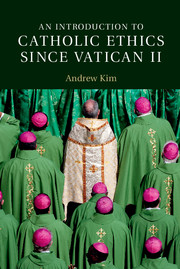Book contents
- Frontmatter
- Dedication
- Epigraph
- Contents
- Foreword
- Preface
- Acknowledgments
- Abbreviations
- Introduction
- PART 1 FOUNDATIONS OF CATHOLIC ETHICS
- PART II GRACE AT THE HEART OF VIRTUE
- PART III CATHOLIC SOCIAL TEACHING
- 7 Justice in the Catholic Moral Tradition
- 8 The Principles of Catholic Social Teaching
- 9 The Just War Tradition
- PART IV BIOETHICS
- Epilogue
- Appendix
- Bibliography
- Index
8 - The Principles of Catholic Social Teaching
from PART III - CATHOLIC SOCIAL TEACHING
Published online by Cambridge University Press: 05 May 2015
- Frontmatter
- Dedication
- Epigraph
- Contents
- Foreword
- Preface
- Acknowledgments
- Abbreviations
- Introduction
- PART 1 FOUNDATIONS OF CATHOLIC ETHICS
- PART II GRACE AT THE HEART OF VIRTUE
- PART III CATHOLIC SOCIAL TEACHING
- 7 Justice in the Catholic Moral Tradition
- 8 The Principles of Catholic Social Teaching
- 9 The Just War Tradition
- PART IV BIOETHICS
- Epilogue
- Appendix
- Bibliography
- Index
Summary
We should recognize how in a culture where each person wants to be bearer of his or her own subjective truth, it becomes difficult for citizens to devise a common plan which transcends individual gain and personal ambitions.
Pope Francis, Evangelli gaudium no. 61Although Catholic social teaching (CST) is anchored in the understanding of justice found in Scripture and the reflections of the early Church fathers, the beginning of CST in its modern form is usually traced back to Leo XIII's 1891 encyclical, Rerum novarum (On Capital and Labor). Pius XI's encyclical, Quadragesimo anno (In the Fortieth Year) followed in 1931. Next came John XXIII's Mater et magistra (Mother and Teacher) in 1961 and Paul VI's Populorum progressio (On the Development of Peoples) in 1967. John Paul II authored a trilogy of encyclicals pertaining to CST: Laborem exercens (On Human Work) in 1981, Sollicitudo rei socialis (The Social Concern) in 1987, and Centesimus annus (One Hundredth Year) in 1991, which marked the one-hundred-year anniversary of Rerum novarum. Subsequent to that was Benedict XVI's 2009 encyclical, Caritas in veritate (Charity in Truth). The most recent statements on CST are Pope Francis's 2013 Apostolic Exhortation, Evangelli gaudium (the Joy of the Gospel), and encyclical Lumen fidei (the Light of Faith). In some respects, all of these documents either anticipate or confirm and expand the presentation of CST put forward in the Second Vatican Council's Pastoral Constitution on the Church in the Modern World, Gaudium et spes, promulgated on December 7, 1965.
Having gained a greater appreciation of the roots of CST in the previous chapter, we may now move on to examine the trunk and branches as understood from the standpoint of the aforementioned documents. The three principles of CST that make up the trunk are human dignity, community, and the common good. The five principles that make up the branches are participation, subsidiarity, preferential option for the poor, stewardship, and solidarity.
- Type
- Chapter
- Information
- An Introduction to Catholic Ethics since Vatican II , pp. 119 - 130Publisher: Cambridge University PressPrint publication year: 2015



